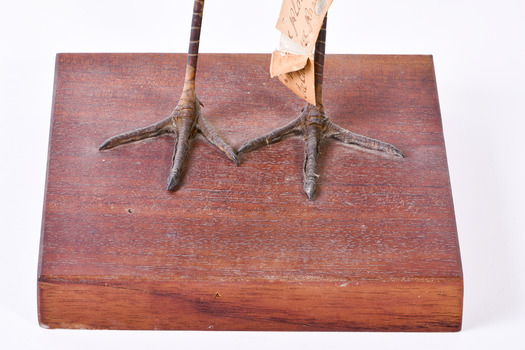Historical information
The Masked Lapwing is a grown-dwelling bird with distinctive large yellow wattles that hang from the sides of its face. The bird has white feathers with black and brown markings. This particular Masked Lapwing has black decorating its hind neck on the sides of the breast which reveal this specimen to be a southern subspecies. The Masked Lapwing appears throughout Australia and is also common in Indonesia, New Guinea, New Caledonia and New Zealand. The Masked Lapwing is known to be fearlessly defendant of its nest and will dive at people who intrude.
This specimen is part of a collection of almost 200 animal specimens that were originally acquired as skins from various institutions across Australia, including the Australian Museum and the National Museum of Victoria, as well as individuals such amateur anthropologist Reynell Eveleigh Johns between 1860-1880. These skins were then mounted by members of the Burke Museum Committee and put-on display in the formal space of the Museum’s original exhibition hall where they continue to be on display. This display of taxidermy mounts initially served to instruct visitors to the Burke Museum of the natural world around them, today it serves as an insight into the collecting habits of the 19th century.
Significance
This specimen is part of a significant and rare taxidermy mount collection in the Burke Museum. This collection is scientifically and culturally important for reminding us of how science continues to shape our understanding of the modern world. They demonstrate a capacity to hold evidence of how Australia’s fauna history existed in the past and are potentially important for future environmental research.
This collection continues to be on display in the Museum and has become a key part to interpreting the collecting habits of the 19th century.
Physical description
The Masked Lapwing is standing on a wooden platform. Its wings are slightly elevated and head is turned towards right wing in a slight decline. The stomach feathers are mostly white and the wings are brown. Black feathers decorate the top of the head, the hind neck and the sides of the breast. The bird has tall legs and long yellow wattles covering its face. The small eyes are made from glass.
Inscriptions & markings
2... Plover See Catalogue, page, 32.
























